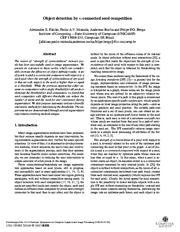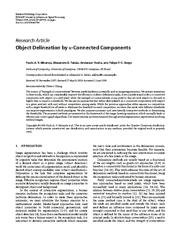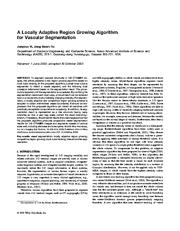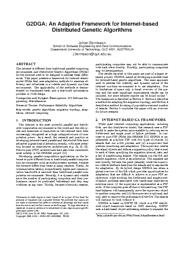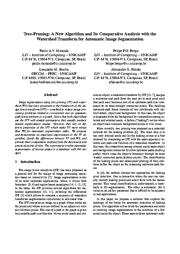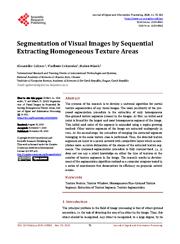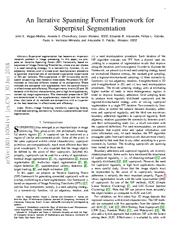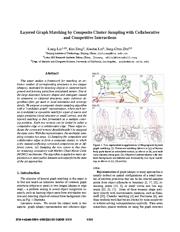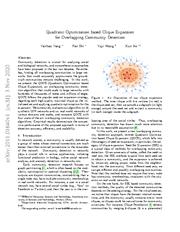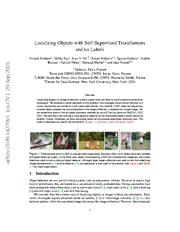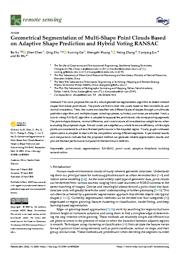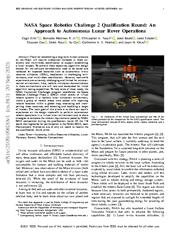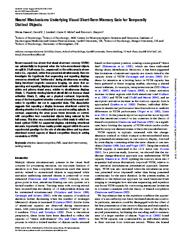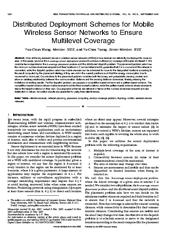A copy of this work was available on the public web and has been preserved in the Wayback Machine. The capture dates from 2017; you can also visit the original URL.
The file type is application/pdf.
Filters
Object Detection by K-Connected Seed Competition
2005
XVIII Brazilian Symposium on Computer Graphics and Image Processing (SIBGRAPI'05)
A set of pixels is said a κ-connected component with respect to a seed pixel when the strength of connectedness of any pixel in that set with respect to the seed is higher than or equal to a threshold. ...
While the previous approaches either assume no competition with a single threshold for all seeds or eliminate the threshold for seed competition, we found that seed competition with different thresholds ...
In object detection with seed competition [17, 10, 21, 1] , the seeds are specified inside and outside the object, each seed defines an influence zone composed by pixels more strongly connected to that ...
doi:10.1109/sibgrapi.2005.34
dblp:conf/sibgrapi/FalcaoMRB05
fatcat:fcrmbl3y5babdkjxyf73atsxpy
Object Delineation by -Connected Components
2008
EURASIP Journal on Advances in Signal Processing
We discuss two approaches that define objects based on κ-connected components with respect to a given seed set: with and without competition among seeds. ...
A set of pixels is said to be a κ-connected component with respect to a seed pixel, when the strength of connectedness of any pixel in that set with respect to the seed is higher than or equal to a threshold ...
When the seed competition fails, these thresholds should limit the influence zones of the seeds avoiding connection between object and background, and the pixels, which are not conquered by any seed, should ...
doi:10.1155/2008/467928
fatcat:qekl6hhp6zajhn2bjlokovczim
A locally adaptive region growing algorithm for vascular segmentation
2003
International journal of imaging systems and technology (Print)
Branch-by-branch labeling for a segmentation result of MRA head data. ...
For segmentation, a locally adaptive and competitive region growing scheme is adopted to obtain well-defined vessel boundaries. ...
By using the extracted nonobject seed areas and the tracked vessel as the object seed area, competitive region growing is performed to segment the current local cube. ...
doi:10.1002/ima.10059
fatcat:3rq5k3sqc5fx3fwc2mu5qazawu
Competitive Evaluation Evaluation of DGAs can be cut if they are being overtaken by other DGAs, or converging. ...
Overtaking is detected by comparing average fitness of a DGA with DGAs with bigger total population size, since it is unlikely that the smaller DGA with lower average fitness will succeed in getting better ...
doi:10.1145/1102256.1102333
dblp:conf/gecco/Berntsson05
fatcat:4jlxykfdezduvoc7iqtqkhqm2u
Tree-Pruning: A New Algorithm and Its Comparative Analysis with the Watershed Transform for Automatic Image Segmentation
2006
Computer Graphics and Image Processing (SIBGRAPI), Proceedings of the Brazilian Symposium on
Image segmentation using tree pruning (TP) and watershed (WS) has been presented in the framework of the image forest transform (IFT)-a method to reduce image processing problems related to connectivity ...
In this case, the competition among internal seeds make object and background connected by a few optimum paths (leaking paths) which cross the object's boundary through its most weakly connected parts ...
The watershed transform Clearly, WS solves segmentation by seed competition for object and background pixels. ...
doi:10.1109/sibgrapi.2006.44
dblp:conf/sibgrapi/MirandaBRF06
fatcat:bterxnlltvccfnysoq7tyrl6li
Segmentation of Visual Images by Sequential Extracting Homogeneous Texture Areas
2020
Journal of Signal and Information Processing
Then, the detected texture segments are input to a neural network with competitive layers which accomplishes more accurate delineation of the shapes of the extracted texture segments. ...
At first, an initial seed point is found for the largest and most homogeneous segment of the image. This initial seed point of the segment is expanded using a region growing method. ...
Inside this test window, an initial seed spot (starting seed) is detected. The initial seed spot is, actually, a patch of pixels. ...
doi:10.4236/jsip.2020.114005
fatcat:klucypbbframthrdd3bz6yummu
Supplementary material for: An Iterative Spanning Forest Framework for Superpixel Segmentation
2019
IEEE Transactions on Image Processing
iii) an adjacency relation, and iv) a seed pixel recomputation procedure to generate improved sets of connected superpixels (supervoxels in 3D) per iteration. ...
In this paper, we propose an Iterative Spanning Forest (ISF) framework, based on sequences of Image Foresting Transforms, where one can choose i) a seed sampling strategy, ii) a connectivity function, ...
, [6] , object detection [7] , spatiotemporal saliency detection [8] , target tracking [9] , and depth estimation [10] . ...
doi:10.1109/tip.2019.2897941
fatcat:xfs3pzjernd4lhdfpok4hi63ky
Layered graph matching by composite cluster sampling with collaborative and competitive interactions
2009
2009 IEEE Conference on Computer Vision and Pattern Recognition
This paper studies a framework for matching an unknown number of corresponding structures in two images (shapes), motivated by detecting objects in cluttered background and learning parts from articulated ...
Each two vertices can be linked by either a competitive edge or a collaborative edge. These edges indicate the connected vertices should/shouldn't be assigned the same color. ...
(II): Object-of-interest objects with cluttered background are detected and localized by two layer matching, as shown in (c), (d) and (e). ...
doi:10.1109/cvprw.2009.5206585
fatcat:dhh65dw7ajf43fswgsijk2plsi
Layered graph matching by composite cluster sampling with collaborative and competitive interactions
2009
2009 IEEE Conference on Computer Vision and Pattern Recognition
This paper studies a framework for matching an unknown number of corresponding structures in two images (shapes), motivated by detecting objects in cluttered background and learning parts from articulated ...
Each two vertices can be linked by either a competitive edge or a collaborative edge. These edges indicate the connected vertices should/shouldn't be assigned the same color. ...
(II): Object-of-interest objects with cluttered background are detected and localized by two layer matching, as shown in (c), (d) and (e). ...
doi:10.1109/cvpr.2009.5206585
dblp:conf/cvpr/LinZLZ09
fatcat:tyn37jkypfdcjpzjdpceakwfsy
Quadratic Optimization based Clique Expansion for Overlapping Community Detection
[article]
2020
arXiv
pre-print
Empirical results demonstrate the competitive performance of the proposed approach in terms of detection accuracy, efficiency, and scalability. ...
QOCE follows the popular seed set expansion strategy, regarding each high-quality maximal clique as the initial seed set and applying quadratic optimization for the expansion. ...
For the four competitive baselines, we use codes provided by the authors. Note that the number of seeds k in NISE and the number of communities k in BIGCLAM and DNMF are hyperparameters. ...
arXiv:2011.01640v1
fatcat:rpnbpzflbfby7k6i7i76ubqmvq
Localizing Objects with Self-Supervised Transformers and no Labels
[article]
2021
arXiv
pre-print
Yet, we outperform state-of-the-art object discovery methods by up to 8 CorLoc points on PASCAL VOC 2012. ...
We also show that training a class-agnostic detector on the discovered objects boosts results by another 7 points. Moreover, we show promising results on the unsupervised object discovery task. ...
A.2 Importance of the seed expansion step We analyse here the importance of the seed expansion step that is controlled by k. ...
arXiv:2109.14279v1
fatcat:ibtrflcqvzfhzj6uqkqpbpejrq
Geometrical Segmentation of Multi-Shape Point Clouds Based on Adaptive Shape Prediction and Hybrid Voting RANSAC
2022
Remote Sensing
The points are first divided into voxels based on their connectivity and normal consistency. ...
Finally, graph-cut-based optimization is adopted to deal with the competition among different segments. ...
Acknowledgments: The authors acknowledge the provision of the Downtown Toronto dataset by Optech Inc., First Base Solutions Inc., GeoICT Lab at York University, and ISPRS WG III/4. ...
doi:10.3390/rs14092024
fatcat:vbt3zxygpvbqxjcubqy7udbmta
NASA Space Robotics Challenge 2 Qualification Round: An Approach to Autonomous Lunar Rover Operations
[article]
2021
arXiv
pre-print
NASA SRC2 competition during the qualification round. ...
To achieve these objectives, algorithm design choices for the software developments need to be tested and validated for expected scenarios such as autonomous in-situ resource utilization (ISRU), localization ...
ACKNOWLEDGMENT The authors would like to thank Nicholas Ohi, Chizhao Yang, Matteo de Petrillo, Rogerio Lima and Trevor Smith for their contributions on the qualification round of the competition, and Ali ...
arXiv:2109.09620v1
fatcat:u2jtaadq4vhddkwmmntkwpawqy
Neural Mechanisms Underlying Visual Short-Term Memory Gain for Temporally Distinct Objects
2014
Cerebral Cortex
In contrast, sequencing the array poses fewer demands on control, with competition from nonattended objects being reduced by the half-arrays. ...
) of clusters showing increased connectivity (=main effect of PPI regressor) to frontoparietal seed regions in the repetition relative to the sequential condition. ...
) competition as in the study by Emrich and Ferber. ...
doi:10.1093/cercor/bhu021
pmid:24554726
fatcat:5c7ziwrjvfb7fnzdpagkiv4324
Distributed Deployment Schemes for Mobile Wireless Sensor Networks to Ensure Multilevel Coverage
2008
IEEE Transactions on Parallel and Distributed Systems
The placement problem asks how the minimum number of sensors required and their locations in I can be determined to guarantee that I is k-covered and the network is connected, while the dispatch problem ...
For the dispatch problem, we propose a competition-based scheme and a pattern-based scheme. ...
Positioning protocols using triangulation [1] require at least three sensors (that is, k ! 3) to detect each location where an object may appear. ...
doi:10.1109/tpds.2007.70808
fatcat:zlzsy6da3vfwfemulpuechrd6q
« Previous
Showing results 1 — 15 out of 41,640 results

